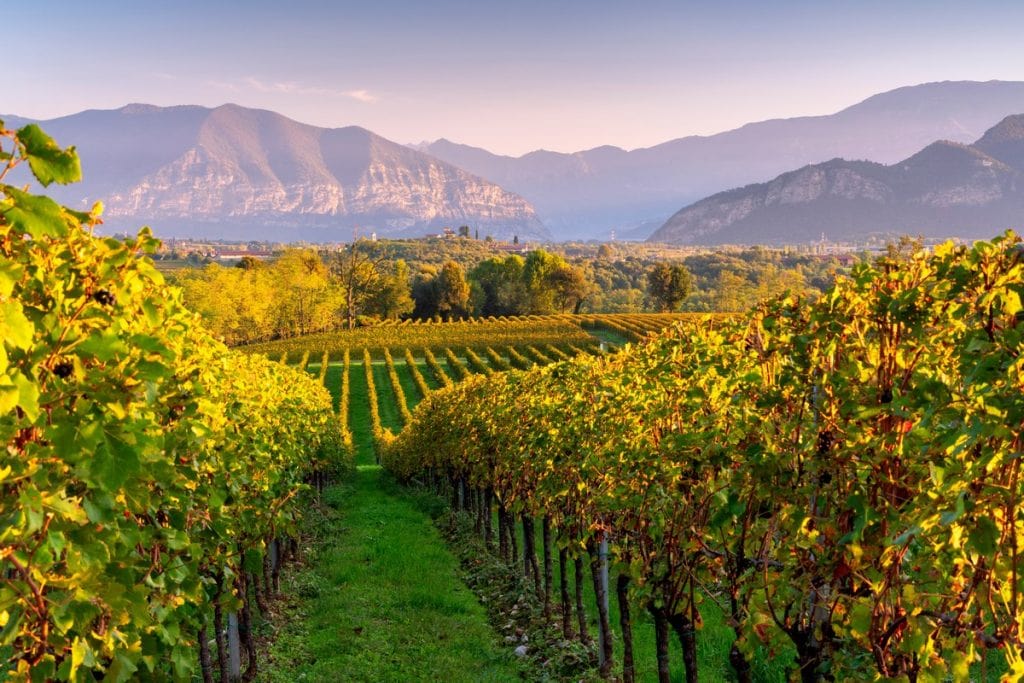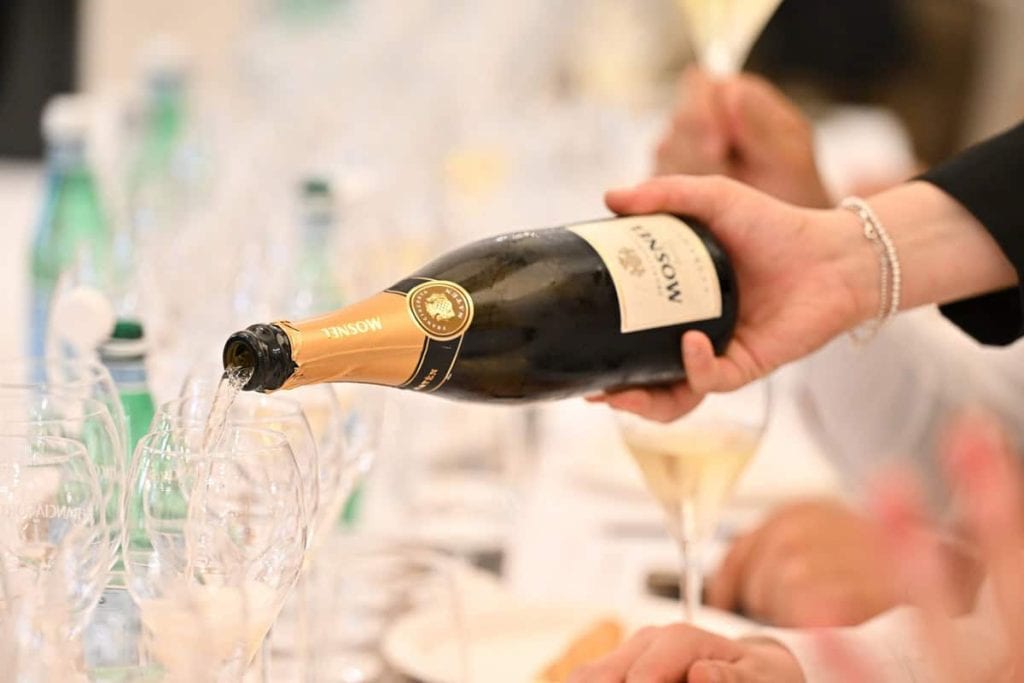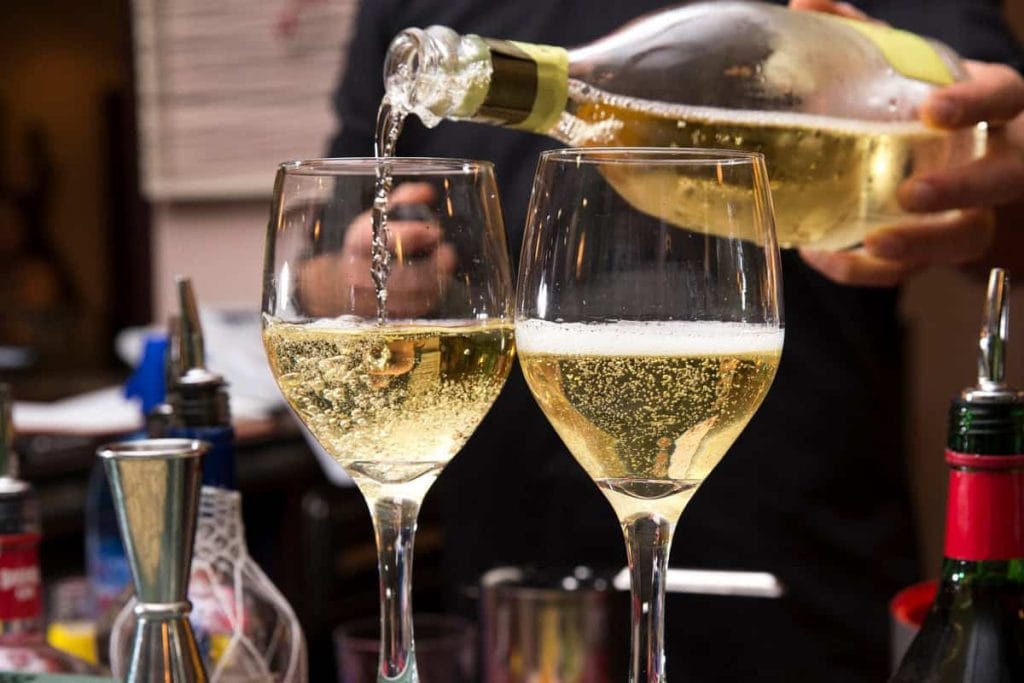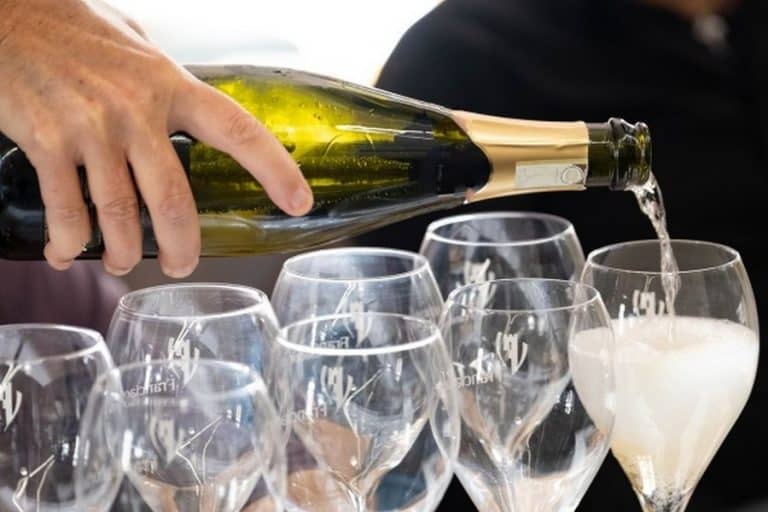Franciacorta, named Wine Region of the Year by Wine Enthusiast, is a hilly area overlooking Lake Iseo in Lombardy, covering approximately 200 square kilometres and comprising 19 municipalities in the province of Brescia. The region’s morainic origin provides the soil with an extraordinary mineral richness, combined with a diverse range of soil types, which form the distinctive features of a high-quality wine-growing region that faced significant challenges during the last harvest due to adverse weather and downy mildew.

Franciacorta: characteristics and types of wines produced
Franciacorta identifies a wine produced exclusively by bottle re-fermentation. Today, the label only bears the term *Franciacorta*, which denotes the wine, its production method, and its territory. For classic-method sparkling wine production, Franciacorta has gained a leading position in Italy, even earning the nickname “Italy’s little Champagne” and achieving DOCG status in 1995.
Franciacorta is made from Chardonnay, Pinot Noir, or PinotBlancgr gapes (with a maximum of 50% Pinot Blanc allowed). Recently, a new grape variety, Erbamat, has been introduced, and some wineries are now experimenting with it. Erbamat is a white grape variety native to Brescia, known since the 16th century but largely forgotten until recently. It is now permitted in the Franciacorta blend up to a maximum of 10%, for all types except Satèn, allowing for gradual experimentation to assess its potential for future use.

© Francesco Vignali Photography
Our tastings this year reaffirmed Lombardy’s national leadership in the classic method in terms of Tre Bicchieri awards, with a strong showing from both Franciacorta and Oltrepò Pavese. The Brescia district presented an ambitious zoning project and demonstrated a new level of production stability, with increasingly well-calibrated dosages and the emergence of new parcelling practices that reflect an ever-deepening territorial adherence, with an impressively high average quality across cuvées. We were particularly struck by the stylistic evolution of many Satèn wines, which had previously received criticism, including from us.
Also noteworthy is the presence of three Franciacorta wines in the Carta dei Vini Rari, a completely new section in the Vini d’Italia guide for 2025 and the focus of the November cover story in Gambero Rosso magazine. These wines include: Franciacorta Dosaggio Zero Annamaria Clementi R.S. Ris. '80 – Ca' del Bosco; Franciacorta Brut Nature Orfano Terre Rosse Ris. '16 – Corte Fusia; and Franciacorta Extra Brut Supèi '17 – Uberti.
Franciacorta: the winemaking process
From the gentle pressing of the grapes, the must for Franciacorta bases is obtained. The first fermentation takes place in tanks, and in the spring, producers create the cuvées by blending wines from different grape varieties, vineyards, and vintages. After blending, sugar and yeast are added to the bottled wine, initiating the second, slow re-fermentation. During the tirage stage, the bottles are sealed with a crown cap and stacked horizontally in cellars, where they remain in contact with the yeast for an extended period. Once ageing is complete, the bottles are placed on inclined racks known as pupitres and rotated daily to move the sediment towards the neck of the bottle.
The crown cap is then removed, and a “dosage syrup” consisting of Franciacorta base wine and sugar is added, determining the Franciacorta’s flavour profile: Dosaggio Zero, Extra Brut, Brut, Extra Dry, Sec or Demi-sec. For Pas Dosé, only base wine is added.
- Franciacorta
Grapes: Chardonnay, Pinot Nero, Pinot Bianco (max. 50%), Erbamat (max. 10%)
Aging: minimo 18 mesi di affinamento
Dosages: Dosaggio Zero, Extra Brut, Brut, Extra Dry, Sec o Dry, Demi sec - Franciacorta Satèn
Grapes: Chardonnay, Pinot Bianco (max. 50%)
Aging: Minimum 24 months of ageing, with reduced pressure to 5 atm
Dosages: Brut - Franciacorta Rosé
Grapes: Pinot Nero (min.35%), Chardonnay (max. 65%), Pinot Bianco (max. 50%), Erbamat (max. 10%)
Aging: Minimum 24 months of ageing
Dosages: Dosaggio Zero, Extra Brut, Brut, Extra Dry, Sec or Dry, Demi-sec - Franciacorta Millesimato, Franciacorta Satèn Millesimato, Franciacorta Rosé Millesimato
Grapes: il millesimo indica che almeno ‘85% del vino proviene da un’unica annata
Aging: Minimum 30 months of ageing
Dosages: Dosaggio Zero, Extra Brut, Brut, Extra Dry, except for Satèn, which is only Brut - Franciacorta Riserva, Franciacorta Satèn Riserva, Franciacorta Rosé Riserva
Aging: Minimo 60 mesi di permanenza sui lieviti
Dosages: Dosaggio Zero, Extra Brut, Brut, except for Satèn, which is only Brut
The best Franciacorta wines awarded Tre Bicchieri
Here are the 10 Franciacorta wines that received the highest award in Gambero Rosso's Vini d'Italia 2025 guide.
For Teatro alla Scala '19, Bellavista demonstrates finesse and complexity with clear and elegant notes of pastry, citrus, and white flowers. On the palate, it is creamy and progressive, tense and layered, with a long and satisfying finish. Bellavista requires little introduction today, not just among sparkling wine enthusiasts but wine lovers in general. However, it is essential to highlight how the forward-thinking leadership of the Moretti family has consistently innovated and stayed ahead, establishing Bellavista as one of the mainstays of Franciacorta. The Bellavista style has become iconic, from the bottle design to the unique interpretation of its entire range of sparkling wines.
The 2019 Dosaggio Zero from Ca' del Bosco's Vintage Collection stands out as the best of the lineup this year. It reaches the peak for consistency, balance, and the finesse of its structure and harmony. Scents of helichrysum and a balanced smoky note enhance a broad and cohesive mouthfeel. Ca' del Bosco is undoubtedly one of the most emblematic names in the Italian wine landscape today. A significant turning point was the entry of the Santa Margherita Group, which has enabled Maurizio Zanella and the indispensable winemaker Stefano Capelli to consolidate the exceptional results already achieved nationally and internationally. This success is also due to unceasing technological research unparalleled in Italy. Its stylistic character is unique, showcasing great richness and complexity throughout its line.
Barone Pizzini's Naturae Edizione 2020 is complete in every respect. Spicy tones, pastry, and citrus blend into a vibrant and fresh mouthfeel, with a refined, well-measured evolutionary trait. At a time when sustainability is central, Barone Pizzini's commitment to organic certification, achieved back in 1997, is admirable. Yet this is only one piece of the puzzle of the company's success. Together with a holistic vision of the land, Barone Pizzini produces wines with a highly recognizable style, establishing it as a point of reference in Franciacorta.
San Cristoforo winery achieves "Tre Bicchieri" for the first time with Dosaggio Zero ND, crafted solely from Chardonnay grapes. The palate is harmonious, crystal-clear, savory, and deep, with a persistent and creamy perlage that enlivens the sip. The nose is intense, elegant, and multifaceted with notes of white fruit, aromatic herbs, and honey, closing long with savory notes and great appeal. Founded by Bruno and Claudia Dotti, the winery is now under the direction of their daughter Celeste, who, with quiet determination and the support of veteran winemaker Beppe and young agronomist and oenologist Nicolò, is carving out her sparkling wine vision. San Cristoforo Franciacortas prioritize clarity and finesse: this year’s offerings are intriguing, with fine, distinctive perlage.
Ferghettina’s Dosaggio Zero Riserva 33 is exemplary in aromatic fragrance and definition, with notes of almond, candied ginger, and lemon peel. It stands out for its elegance and overall balance, with a long, harmonious finish. In 1991, Roberto Gatti bottled the first vintage from 4 hectares of vineyards. Hard work, meticulous vineyard care, and high quality across the entire product range have elevated the company to the top of the denomination. Today, 200 hectares are skillfully cultivated by the Gatti family across 20 Franciacorta municipalities, allowing enologist siblings Laura and Matteo to interpret the land with unmatched insight, year after year.
The 2019 Boschedòr Extra Brut from Bosio offers a sip of extraordinary pleasure and elegance. Its aromatic spectrum is broad and nuanced, with notes of pastry and white fruit flesh; on the palate, it is marked by a savory rhythm, vibrant freshness, and length. The finish is clean, long, and lively. Led by siblings Cesare and Laura, Bosio is carving out a prominent place in the ever-evolving Franciacorta scene. Production is limited, focusing on quality throughout the line, ensuring enviable consistency. With great attention in the vineyard and a constant drive for innovation in the cellar, Bosio has become a benchmark for lovers of gastronomic sparkling wines with strong gustatory tension.
Mosnel’s Extra Brut EBB 2018 is superb with long-term aging potential, showing class and concentration that promises to evolve. Over recent years, the winery, managed by Lucia and Giulio Barzanò, the fifth generation of the family, has become synonymous with guaranteed quality. Its 40 hectares of organic vineyards are located in the finest positions of Passirano, Camignone, and surrounding areas. The 16th-century villa housing the winery is well worth visiting. Mosnel wines are characterized by elegance, savoriness, and creaminess.
Castello Bonomi's Lucrezia Riserva '11 truly impressed us. This Rosé offers captivating elegance with a broad olfactory profile, combining pomegranate and watermelon notes with an exquisitely refined spice nuance. The mouthfeel is lively, well-defined, and marked by vibrant, bright freshness. This outstanding vintage is embodied in a fine cuvée. Since acquiring the estate in 2008, the Paladin family has retained Luigi Bersini, the chef de cave since 1985. A wise decision, given the wine’s quality: Castello Bonomi’s wines, made from estate vineyards on Monte Orfano, continue to express a clear, well-defined identity. The style is rich and gastronomic, yet maintains an excellent freshness, a true expression of this limestone-gypsum terroir.
The 2017 Nature Rosé 61 from Guido Berlucchi Franciacorta is remarkable, with inviting soft tones of raspberry, pomegranate, coffee, and brioche. The palate is enveloping and progressive, featuring depth and resilience, with woven tactile sensations and a precise, long finish. If we can enjoy some of Italy’s finest sparkling wines today, we owe much to the visionary Franco Ziliani and Guido Berlucchi, who together believed in Franciacorta as a land for great sparkling wines. Over sixty years later, under the watchful eyes of the new generation—Arturo, Cristina, and Paolo—the company continues to lead this wine region. The Metodo Classico range is of high quality, reaching peaks of excellence in the 61 and Palazzo Lana lines.
Muratori’s Satèn stands out for its aromatic fragrance, perlage, and elegance in gustatory phrasing. It offers aromas of peach, almond, and apple, with a delicious, rhythmically paced mouthfeel and a very long, juicy finish. Historic Villa Crespia, located on the picturesque hill of Adro, has housed Muratori’s winery since 1999. Sustainability is increasingly central to this winery’s mission: in addition to organic vineyard cultivation, the estate is energy self-sufficient, thanks to its agrivoltaic system, while grapes are gravity-fed in the underground cellar. With wines crafted from all six Franciacorta vocated zones, Muratori collaborates with enologist Riccardo Cotarella.
Cover photo by Salvatore Cascone.


 Meloni: "Tariffs? If necessary, there will be consequences. Heavy impact on agri-food sector"
Meloni: "Tariffs? If necessary, there will be consequences. Heavy impact on agri-food sector" The Government honours the greats of Italian cuisine, from Bottura to Pepe. Massari: "Thank you, Meloni, the only one who listened to us"
The Government honours the greats of Italian cuisine, from Bottura to Pepe. Massari: "Thank you, Meloni, the only one who listened to us" "We must promote a cuisine that is not just for the few." Interview with Massimo Bottura
"We must promote a cuisine that is not just for the few." Interview with Massimo Bottura Wine was a drink of the people as early as the Early Bronze Age. A study disproves the ancient elitism of Bacchus’ nectar
Wine was a drink of the people as early as the Early Bronze Age. A study disproves the ancient elitism of Bacchus’ nectar "From 2nd April, US tariffs between 10% and 25% on wine as well." The announcement from the Wine Trade Alliance
"From 2nd April, US tariffs between 10% and 25% on wine as well." The announcement from the Wine Trade Alliance







